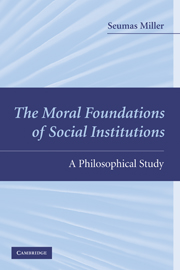1 - A Teleological Account of Institutions
Published online by Cambridge University Press: 05 June 2012
Summary
Teleological accounts of social action in general, and of social institutions in particular, fall within the individualist philosophy of action tradition that has its intellectual roots in Aristotle, Hume, and Kant and is associated with contemporary analytic philosophers of social action such as Michael Bratman (1987), John Searle (1995), and Raimo Tuomela (2002). However, this way of proceeding also has a place outside philosophy in sociological theory. Broadly speaking, it is the starting point for the voluntaristic theory of social action associated with the likes of Max Weber (1949) and (the early) Talcott Parsons (1968). Consider, for example, the following idea in relation to social action expressed by Parsons (1968, 229): “actions do not take place each with a separate, discrete end in relation to the situation, but in long complicated chains … [and] the total complex of means-end relationships is not to be thought of as similar to a large number of parallel threads, but as a complicated web (if not a tangle).”
JOINT ACTION
The central concept in the teleological account of social institutions is that of joint action. Joint actions are actions involving a number of agents performing interdependent actions to realize some common goal. Examples of joint action are two people dancing together, a number of tradesmen building a house, and a group of robbers burgling a house. Joint action is to be distinguished from individual action, on the one hand, and from the “actions” of corporate bodies, on the other.
- Type
- Chapter
- Information
- The Moral Foundations of Social InstitutionsA Philosophical Study, pp. 37 - 55Publisher: Cambridge University PressPrint publication year: 2009



